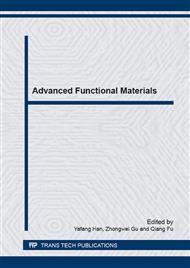[1]
J.B. Pendry, D. Schurig and D.R. Smith: science Vol. 312 (2006), pp.1780-1782.
Google Scholar
[2]
N. Fang, H. Lee, C. Sun and X. Zhang: Science Vol. 308 (2005), pp.534-537.
Google Scholar
[3]
Z.C. Shi, R.H. Fan, Z.Z. Zhang K.L. Yan, X.H. Zhang, K. Sun, X.F. Liu and C.G. Wang: Journal of Materials Chemistry C, Vol. 1 (2013), pp.1633-1637.
Google Scholar
[4]
D. R. Smith, W.J. Padilla, D.C. Vier, S.C. Nemat-Nasser, and S. Schultz: Physical review letters Vol. 84 (2000), p.4184.
Google Scholar
[5]
M. Kafesaki, I. Tsiapa, N. Katsarakis, T. Koschny, C.M. Soukoulis, and E.N. Economou: Physical Review B Vol 75 (2007), 235114.
DOI: 10.1103/physrevb.75.235114
Google Scholar
[6]
T. Feng, Y. Li, H. Jiang, W. Li, F. Yang, X. Dong, and H. Chen: Progress In Electromagnetics Research, Vol. 120(2011), pp.35-50.
Google Scholar
[7]
Z.C. Shi, R.H. Fan, Z.D. Zhang, Q. Lei, M. Gao, M. Zhang, L.T. Zheng, X.H. Zhang andL.W. Yin: Advanced Materials Vol. 24 (2012), pp.2349-2352.
Google Scholar
[8]
M. Gao, Z.C. Shi, R.H. Fan, L. Qian, Z.D. Zhang and J.Y. Guo: Journal of the American Ceramic Society Vol. 95 (2012), pp.67-70.
Google Scholar
[9]
A. Pimenov, A. Loidl, K. Gehrke, V. Moshnyaga, and K. Samwer: Physical review letters Vol. 98 (2007), 197401.
Google Scholar
[10]
S.T. Chui, Z.F. Lin, and L.B. Hu: Physics Letters A Vol. 319 (2003), pp.85-88.
Google Scholar
[11]
S. Engelbrecht, A.M. Shuvaev, Y. Luo, V. Moshnyaga and A. Pimenov: Europhysics Letters Vol. 95 (2011), 37005.
DOI: 10.1209/0295-5075/95/37005
Google Scholar
[12]
B. Li, G. Sui, W.H. Zhong: Advanced Materials Vol. 21 (2009), pp.4176-4180.
Google Scholar
[13]
J.K.W. Sandler, J.E. Kirk, I.A. Kinloch, M.S.P. Shaffer1, and A.H. Windle: Polymer Vol. 44 (2003), pp.5893-5899.
Google Scholar
[14]
S.Y. Yang, C.C.M. Ma, C.C. Teng, Y.W. Huang, S.H. Liao, Y.L. Huang, H.W. Tien, T.M. Lee and K.C. Chiou: Carbon Vol. 48 (2010), p.592–603.
Google Scholar
[15]
S.Y. Yang, W.N. Lin, Y.L. Huang, H.W. Tien, J.Y. Wang C.C.M. Ma, S.M. Li and Y.S. Wang: Carbon Vol. 3 (2011), pp.793-803.
Google Scholar
[16]
Q. Hou, Z.C. Shi, R.H. Fan and L.C. Ju: Key Engineering Materials Vol. 512(2012), pp.127-131.
Google Scholar


